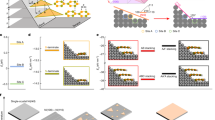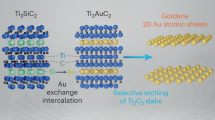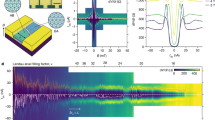Abstract
Graphene nanoribbons are of potential use in the development of electronic and optoelectronic devices. However, the preparation of narrow and long nanoribbons with smooth edges, sizeable bandgaps and high mobilities is challenging. Here we show that sub-10-nm-wide semiconducting graphene nanoribbons with atomically smooth closed edges can be produced by squashing carbon nanotubes using a high-pressure and thermal treatment. With this approach, nanoribbons as narrow as 1.4 nm can be created, and up to 54% of single- and double-walled nanotubes in a sample can be converted into edge-closed nanoribbons. We also fabricate edge-opened nanoribbons using nitric acid as the oxidant to selectively etch the edges of the squashed nanotubes under high pressure. A field-effect transistor fabricated using a 2.8-nm-wide edge-closed nanoribbon exhibits an on/off current ratio of more than 104, from which a bandgap of around 494 meV is estimated. The device also exhibits a field-effect mobility of 2,443 cm2 V−1 s−1 and an on-state channel conductivity of 7.42 mS.
This is a preview of subscription content, access via your institution
Access options
Access Nature and 54 other Nature Portfolio journals
Get Nature+, our best-value online-access subscription
$29.99 / 30 days
cancel any time
Subscribe to this journal
Receive 12 digital issues and online access to articles
$119.00 per year
only $9.92 per issue
Buy this article
- Purchase on Springer Link
- Instant access to full article PDF
Prices may be subject to local taxes which are calculated during checkout






Similar content being viewed by others
Data availability
The data that support the plots within this paper and other findings of this study are available from the corresponding authors upon reasonable request.
References
Schwierz, F. Graphene transistors. Nat. Nanotechnol. 5, 487–496 (2010).
Yazyev, O. V. A guide to the design of electronic properties of graphene nanoribbons. Acc. Chem. Res. 46, 2319–2328 (2013).
Yang, L., Park, C. H., Son, Y. W., Cohen, M. L. & Louie, S. G. Quasiparticle energies and band gaps in graphene nanoribbons. Phys. Rev. Lett. 99, 186801 (2007).
Son, Y. W., Cohen, M. L. & Louie, S. G. Energy gaps in graphene nanoribbons. Phys. Rev. Lett. 97, 216803 (2006).
Wang, X. R. et al. Room-temperature all-semiconducting sub-10-nm graphene nanoribbon field-effect transistors. Phys. Rev. Lett. 100, 206803 (2008).
Li, X. L., Wang, X. R., Zhang, L., Lee, S. W. & Dai, H. J. Chemically derived, ultrasmooth graphene nanoribbon semiconductors. Science 319, 1229–1232 (2008).
Jiao, L. Y., Zhang, L., Wang, X. R., Diankov, G. & Dai, H. J. Narrow graphene nanoribbons from carbon nanotubes. Nature 458, 877–880 (2009).
Kimouche, A. et al. Ultra-narrow metallic armchair graphene nanoribbons. Nat. Commun. 6, 10177 (2015).
Ma, C. X. et al. Seamless staircase electrical contact to semiconducting graphene nanoribbons. Nano Lett. 17, 6241–6247 (2017).
Chen, C. X. et al. Graphene nanoribbons under mechanical strain. Adv. Mater. 27, 303–309 (2015).
Xie, L. M. et al. Graphene nanoribbons from unzipped carbon nanotubes: atomic structures, Raman spectroscopy, and electrical properties. J. Am. Chem. Soc. 133, 10394–10397 (2011).
Fang, T., Konar, A., Xing, H. L. & Jena, D. Mobility in semiconducting graphene nanoribbons: phonon, impurity, and edge roughness scattering. Phys. Rev. B 78, 205403 (2008).
Basu, D., Gilbert, M. J., Register, L. F., Banerjee, S. K. & MacDonald, A. H. Effect of edge roughness on electronic transport in graphene nanoribbon channel metal-oxide-semiconductor field-effect transistors. Appl. Phys. Lett. 92, 042114 (2008).
Han, M. Y., Ozyilmaz, B., Zhang, Y. B. & Kim, P. Energy band-gap engineering of graphene nanoribbons. Phys. Rev. Lett. 98, 206805 (2007).
Jiao, L. Y., Wang, X. R., Diankov, G., Wang, H. L. & Dai, H. J. Facile synthesis of high-quality graphene nanoribbons. Nat. Nanotechnol. 5, 321–325 (2010).
Wang, X. R. et al. Graphene nanoribbons with smooth edges behave as quantum wires. Nat. Nanotechnol. 6, 563–567 (2011).
Kosynkin, D. V. et al. Longitudinal unzipping of carbon nanotubes to form graphene nanoribbons. Nature 458, 872–876 (2009).
Pan, M. H. et al. Topographic and spectroscopic characterization of electronic edge states in CVD grown graphene nanoribbons. Nano Lett. 12, 1928–1933 (2012).
Oliveira, M. H. et al. Synthesis of quasi-free-standing bilayer graphene nanoribbons on SiC surfaces. Nat. Commun. 6, 7632 (2015).
Wang, X. R. & Dai, H. J. Etching and narrowing of graphene from the edges. Nat. Chem. 2, 661–665 (2010).
Bai, J. W., Duan, X. F. & Huang, Y. Rational fabrication of graphene nanoribbons using a nanowire etch mask. Nano Lett. 9, 2083–2087 (2009).
Yu, F. et al. Controlled fabrication of intermolecular junctions of single-walled carbon nanotube/graphene nanoribbon. Small 9, 2405–2409 (2013).
Magda, G. Z. et al. Room-temperature magnetic order on zigzag edges of narrow graphene nanoribbons. Nature 514, 608–611 (2014).
Yang, W. L., Lucotti, A., Tommasini, M. & Chalifoux, W. A. Bottom-up synthesis of soluble and narrow graphene nanoribbons using alkyne benzannulations. J. Am. Chem. Soc. 138, 9137–9144 (2016).
Narita, A. et al. Synthesis of structurally well-defined and liquid-phase-processable graphene nanoribbons. Nat. Chem. 6, 126–132 (2014).
Grosse, K. L., Bae, M. H., Lian, F. F., Pop, E. & King, W. P. Nanoscale Joule heating, Peltier cooling and current crowding at graphene–metal contacts. Nat. Nanotechnol. 6, 287–290 (2011).
Xia, F. N., Perebeinos, V., Lin, Y.-M., Wu, Y. Q. & Avouris, P. The origins and limits of metal–graphene junction resistance. Nat. Nanotechnol. 6, 179–184 (2011).
Huang, B.-C., Zhang, M., Wang, Y. J. & Woo, J. Contact resistance in top-gated graphene field-effect transistors. Appl. Phys. Lett. 99, 032107 (2011).
Cai, J. M. et al. Atomically precise bottom-up fabrication of graphene nanoribbons. Nature 466, 470–473 (2010).
Ruffieux, P. et al. On-surface synthesis of graphene nanoribbons with zigzag edge topology. Nature 531, 489–492 (2016).
Jacobse, P. H. et al. Electronic components embedded in a single graphene nanoribbon. Nat. Commun. 8, 119 (2017).
Kolmer, M. et al. Rational synthesis of atomically precise graphene nanoribbons directly on metal oxide surfaces. Science 369, 571–575 (2020).
Ma, J., Wang, J. N. & Wang, X. X. Large-diameter and water-dispersible single-walled carbon nanotubes: synthesis, characterization and applications. J. Mater. Chem. 19, 3033–3041 (2009).
Qi, H., Qian, C. & Liu, J. Synthesis of high-purity few-walled carbon nanotubes from ethanol/methanol mixture. Chem. Mater. 18, 5691–5695 (2006).
Liew, K. M. & Sun, Y. Z. Elastic properties and pressure-induced structural transitions of single-walled carbon nanotubes. Phys. Rev. B 77, 205437 (2008).
Elliott, J. A., Sandler, J. K. W., Windle, A. H., Young, R. J. & Shaffer, M. S. P. Collapse of single-wall carbon nanotubes is diameter dependent. Phys. Rev. Lett. 92, 095501 (2004).
Mu, W. H., Cao, J. S. & Ou-Yang, Z. C. Shape transition of unstrained flattest single-walled carbon nanotubes under pressure. J. Appl. Phys. 115, 044512 (2014).
Gillen, R., Mohr, M., Thomsen, C. & Maultzsch, J. Vibrational properties of graphene nanoribbons by first-principles calculations. Phys. Rev. B 80, 115418 (2009).
Talirz, L. et al. On-surface synthesis and characterization of 9-atom wide armchair graphene nanoribbons. ACS Nano 11, 1380 (2017).
Peköz, R., Feng, X. L. & Donadio, D. Ab initio characterization of graphene nanoribbons and their polymer precursors. J. Phys.: Condens. Matter 24, 104023 (2012).
Borin, B. G. et al. Surface-synthesized graphene nanoribbons for room temperature switching devices: substrate transfer and ex situ characterization. ACS Appl. Nano Mater. 2, 2184–2192 (2019).
Fairbrother, A. et al. High vacuum synthesis and ambient stability of bottom-up graphene nanoribbons. Nanoscale 9, 2785–2792 (2017).
Sanders, G. D., Nugraha, A. R. T., Saito, R. & Stanton, C. J. Coherent radial-breathing-like phonons in graphene nanoribbons. Phys. Rev. B 85, 205401 (2012).
Chen, Z. H., Lin, Y.-M., Rooks, M. J. & Avouris, P. Graphene nano-ribbon electronics. Phys. E 40, 228–232 (2007).
Pantano, A. Effects of mechanical deformation on electronic transport through multiwall carbon nanotubes. Int. J. Solids Struct. 122–123, 33–41 (2017).
Impellizzeri, A., Briddon, P. & Ewels, C. P. Stacking- and chirality-dependent collapse of single-walled carbon nanotubes: a large-scale density-functional study. Phys. Rev. B 100, 115410 (2019).
Llinas, J. P. et al. Short-channel field-effect transistors with 9-atom and 13-atom wide graphene nanoribbons. Nat. Commun. 8, 633 (2017).
Murakami, K. et al. Synthesis of graphene nanoribbons from amyloid templates by gallium vapor-assisted solid-phase graphitization. Appl. Phys. Lett. 104, 243101 (2014).
Jordan, R. S. et al. Synthesis of graphene nanoribbons via the topochemical polymerization and subsequent aromatization of a diacetylene precursor. Chem 1, 78–90 (2016).
Hwang, W. S. et al. Graphene nanoribbon field-effect transistors on wafer-scale epitaxial graphene on SiC substrates. APL Mater. 3, 011101 (2015).
Mao, H., Xu, J. & Bell, P. M. Calibration of the ruby pressure gauge to 800 kbar under quasi-hydrostatic conditions. J. Geophys. Res. B 91, 4673 (1986).
Acknowledgements
C.C. acknowledges support from the National Natural Science Foundation of China for Excellent Young Scholars (no. 61622404), Chang Jiang (Cheung Kong) Scholars Program of Ministry of Education of China (no. Q2017081), National Natural Science Foundation of China (no. 62074098) and Science and Technology Innovation Action Program from the Science and Technology Commission of Shanghai Municipality (no. 15520720200). Y.L., W.L.M. and the high-pressure DAC experiments were supported by the United States Department of Energy through the Stanford Institute for Materials and Energy Sciences DE-AC02-76SF00515. Work by J.N.W. was supported by the National Key R&D Program of China (2018YFA0208404) and Innovation Program of Shanghai Municipal Education Commission. J.G. was supported by NSF grant nos. 1809770 and 1904580. Work at ORNL was supported by the US Department of Energy, Office of Science, Basic Energy Sciences, Materials Sciences and Engineering Division. W.Z. acknowledges support from the Beijing Outstanding Young Scientist Program (BJJWZYJH01201914430039).
Author information
Authors and Affiliations
Contributions
H.D. and C.C. conceived and designed the experiments and C.C. conceived the theoretical calculations and simulations. C.C. planned and supervised the project. C.C., Y.L., W.Z., M.G., Z.H., F.S., X.L., J.Z.W., J.N.W., F.Y., Q.Z., J.L., G.H., A.L.A. and M.-C.L. performed the experiments and prepared the pristine CNT samples. C.C., Z.H., K.T.L., J.G., W.G. and J.-M.Z. performed the numerical simulations. C.C., Y.L., W.Z., M.G., Z.H., F.S., X.L., J.Z.W., K.T.L., F.Y., Q.Z., J.G., W.G., J.-M.Z., G.H., W.L.M. and H.D. analysed the data and wrote the manuscript. All the authors discussed the results and commented on the manuscript.
Corresponding authors
Ethics declarations
Competing interests
The authors declare no competing interests.
Additional information
Peer review information Nature Electronics thanks Antonio Pantano, Chee-Tat Toh and An-Ping Li for their contribution to the peer review of this work.
Publisher’s note Springer Nature remains neutral with regard to jurisdictional claims in published maps and institutional affiliations.
Supplementary information
Supplementary Information
Supplementary Figs. 1–20, Table 1 and Notes 1–3.
Rights and permissions
About this article
Cite this article
Chen, C., Lin, Y., Zhou, W. et al. Sub-10-nm graphene nanoribbons with atomically smooth edges from squashed carbon nanotubes. Nat Electron 4, 653–663 (2021). https://doi.org/10.1038/s41928-021-00633-6
Received:
Accepted:
Published:
Issue Date:
DOI: https://doi.org/10.1038/s41928-021-00633-6



